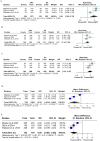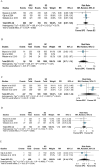Efficacy and Safety of Low-Dose Triple Single Pill Combination Versus Standard Care in the Management of Hypertension in Low- and Middle-Income Countries: A Systematic Review and Meta-analysis of Three Randomized Controlled Trials
- PMID: 40488970
- PMCID: PMC12310858
- DOI: 10.1007/s40292-025-00720-1
Efficacy and Safety of Low-Dose Triple Single Pill Combination Versus Standard Care in the Management of Hypertension in Low- and Middle-Income Countries: A Systematic Review and Meta-analysis of Three Randomized Controlled Trials
Abstract
Introduction: Low Low-dose triple single pill combination therapy is recommended for hypertension treatment. However, the efficacy and safety of these combinations in low- and middle-income countries (LMICs) remain unclear.
Aim: We conducted a systematic review and meta-analysis to evaluate the efficacy and safety of low-dose triple single pill combination therapy in controlling blood pressure (BP) in LMICs.
Methods: We systematically searched PubMed, Embase, Cochrane, and ClinicalTrials.gov for randomised controlled trials (RCTs) comparing low-dose triple single pill combination therapy with standard care for hypertension management up to 29 January 2025. Mean differences (MD) were computed for continuous outcomes and risk ratio (RR) with 95% confidence intervals (CI) for binary outcomes.
Results: Three RCTs comprising 1758 patients, of whom 752 (43%) received low-dose triple single pill combination therapy, were included. The proportion of patients that achieved target BP at six weeks was higher with this therapy (RR 1.89; 95% CI 1.29, 2.75; P < 0.001). Compared with standard care, it significantly reduced SBP (MD - 5.30 mmHg; 95% CI - 9.55, - 0.92; P = 0.017), DBP (MD - 3.50 mmHg; 95% CI - 4.95, - 2.05; P < 0.001), and urine albumin-to-creatinine ratio (RR 0.59; 95% CI 0.44, 0.80; P < 0.001). No significant differences in adherence, withdrawal, or adverse effects were observed between groups.
Conclusion: In this meta-analysis, the use of a low-dose triple single pill combination in hypertensive patients in LMICs led to earlier and sustained blood pressure control and reduced urine albumin-to-creatinine ratio, with a safety profile comparable to standard care. PROSPERO registration: Number: CRD42025647884, Date: 15 February 2025.
Keywords: Blood pressure control; Hypertension; Low- and middle-income countries (LMICs); Low-dose triple single pill combination therapy; Meta-analysis; Randomized controlled trials (RCTs).
© 2025. The Author(s).
Conflict of interest statement
Declarations. Conflict of interest: All authors certify that they have no affiliations with or involvement in any organizationor entity with any financial interest or non-financial interest in the subject matter or materialsdiscussed in this manuscript. Ethics Approval: The work described has not been published, it is not under consideration for publicationelsewhere, and its publication is approved by all authors and tacitly or explicitly by theresponsible authorities where the work was carried out; if accepted, it will not be publishedelsewhere in the same form, in English or in any other language, including electronically, withoutthe written consent of the copyright-holder. Consent to Publish: The authors of the present study give consent to publish this paper.
Figures




Similar articles
-
Blood pressure-lowering efficacy of monotherapy with thiazide diuretics for primary hypertension.Cochrane Database Syst Rev. 2014 May 29;2014(5):CD003824. doi: 10.1002/14651858.CD003824.pub2. Cochrane Database Syst Rev. 2014. PMID: 24869750 Free PMC article.
-
Systemic pharmacological treatments for chronic plaque psoriasis: a network meta-analysis.Cochrane Database Syst Rev. 2021 Apr 19;4(4):CD011535. doi: 10.1002/14651858.CD011535.pub4. Cochrane Database Syst Rev. 2021. Update in: Cochrane Database Syst Rev. 2022 May 23;5:CD011535. doi: 10.1002/14651858.CD011535.pub5. PMID: 33871055 Free PMC article. Updated.
-
Fixed-dose combination therapy for the prevention of atherosclerotic cardiovascular diseases.Cochrane Database Syst Rev. 2017 Mar 6;3(3):CD009868. doi: 10.1002/14651858.CD009868.pub3. Cochrane Database Syst Rev. 2017. PMID: 28263370 Free PMC article.
-
Blood pressure lowering efficacy of renin inhibitors for primary hypertension.Cochrane Database Syst Rev. 2017 Apr 5;4(4):CD007066. doi: 10.1002/14651858.CD007066.pub3. Cochrane Database Syst Rev. 2017. PMID: 28379619 Free PMC article.
-
Drugs for preventing postoperative nausea and vomiting in adults after general anaesthesia: a network meta-analysis.Cochrane Database Syst Rev. 2020 Oct 19;10(10):CD012859. doi: 10.1002/14651858.CD012859.pub2. Cochrane Database Syst Rev. 2020. PMID: 33075160 Free PMC article.
References
-
- Schutte AE, Botha S, Fourie CMT, Gafane-Matemane LF, Kruger R, Lammertyn L, Malan L, Mels CMC, Schutte R, Smith W, van Rooyen JM, Ware LJ, Huisman HW. Recent advances in understanding hypertension development in sub-Saharan Africa. J Hum Hypertens. 2017;31(8):491–500. - PubMed
-
- Olsen MH, Angell SY, Asma S, Boutouyrie P, Burger D, Chirinos JA, Damasceno A, Delles C, Gimenez-Roqueplo AP, Hering D, López-Jaramillo P, Martinez F, Perkovic V, Rietzschel ER, Schillaci G, Schutte AE, Scuteri A, Sharman JE, Wachtell K, Wang JG. A call to action and A life course strategy to address the global burden of raised blood pressure on current and future generations: the lancet commission on hypertension. Lancet. 2016;388:2665–26712. - PubMed
-
- Coca A, Whelton SP, Camafort M, López-López JP, Yang E. Single-pill combination for treatment of hypertension: Just a matter of practicality or is there a real clinical benefit? Eur J Intern Med. 2024;126:16–25. - PubMed
Publication types
MeSH terms
Substances
LinkOut - more resources
Full Text Sources
Medical

